Notice: After Volume 3 2025 (Mid of Sep 2025), feature enhancements for this control will no longer be available in the Syncfusion® package. Please switch to the Syncfusion® Toolkit for .NET MAUI for continued support. For a smooth transition refer this migration document.
Getting started with .NET MAUI Picker
19 Dec 202517 minutes to read
This section explains how to add the .NET MAUI Picker control. It covers only the basic features needed to get started with the Syncfusion Picker. Follow the steps below to add a .NET MAUI Picker control to your project.
To get start quickly with our .NET MAUI Picker, you can check the below video.
Prerequisites
Before proceeding, ensure the following are set up:
- Install .NET SDK
- .NET 9 SDK or later must be installed.
- Set up a .NET MAUI Environment with Visual Studio. Supported Visual Studio Versions:
- Visual Studio 2022: Version 17.13 or later (e.g., 17.14.7) for .NET 9 development.
- Visual Studio 2026: Required for .NET 10 development.
Step 1: Create a New .NET MAUI Project
- Go to File > New > Project and choose the .NET MAUI App template.
- Name the project and choose a location. Then click Next.
- Select the .NET framework version and click Create.
Step 2: Install the Syncfusion® .NET MAUI Picker NuGet Package
- In Solution Explorer, right-click the project and choose Manage NuGet Packages.
- Search for Syncfusion.Maui.Picker and install the latest version.
- Ensure the necessary dependencies are installed correctly, and the project is restored.
Step 3: Register the handler
The Syncfusion.Maui.Core NuGet is a dependent package for all Syncfusion® controls of .NET MAUI. In the MauiProgram.cs file, register the handler for Syncfusion® core.
using Syncfusion.Maui.Core.Hosting;
namespace GettingStarted
{
public static class MauiProgram
{
public static MauiApp CreateMauiApp()
{
var builder = MauiApp.CreateBuilder();
builder.ConfigureSyncfusionCore();
builder
.UseMauiApp<App>()
.ConfigureFonts(fonts =>
{
fonts.AddFont("OpenSans-Regular.ttf", "OpenSansRegular");
});
return builder.Build();
}
}
}Step 4: Add .NET MAUI Picker control
- To initialize the control, import the
Syncfusion.Maui.Pickernamespace into your code. - Initialize SfPicker.
<ContentPage
. . .
xmlns:picker="clr-namespace:Syncfusion.Maui.Picker;assembly=Syncfusion.Maui.Picker">
<picker:SfPicker />
</ContentPage>using Syncfusion.Maui.Picker;
. . .
public partial class MainPage : ContentPage
{
public MainPage()
{
InitializeComponent();
SfPicker picker = new SfPicker();
this.Content = picker;
}
}Prerequisites
Before proceeding, ensure the following are set up:
- Install .NET 9 SDK or later is installed.
- Set up a .NET MAUI environment with Visual Studio Code.
- Ensure that the .NET MAUI extension is installed and configured as described here.
Step 1: Create a New .NET MAUI Project
- Open the command palette by pressing
Ctrl+Shift+Pand type .NET:New Project and enter. - Choose the .NET MAUI App template.
- Select the project location, type the project name and press Enter.
- Then choose Create project.
Step 2: Install the Syncfusion® .NET MAUI Picker NuGet Package
- Press Ctrl + ` (backtick) to open the integrated terminal in Visual Studio Code.
- Ensure you’re in the project root directory where your .csproj file is located.
- Run the command
dotnet add package Syncfusion.Maui.Mapsto install the Syncfusion® .NET MAUI Maps NuGet package. - To ensure all dependencies are installed, run
dotnet restore.
Step 3: Register the handler
The Syncfusion.Maui.Core NuGet is a dependent package for all Syncfusion® controls of .NET MAUI. In the MauiProgram.cs file, register the handler for Syncfusion® core.
using Syncfusion.Maui.Core.Hosting;
namespace GettingStarted
{
public static class MauiProgram
{
public static MauiApp CreateMauiApp()
{
var builder = MauiApp.CreateBuilder();
builder.ConfigureSyncfusionCore();
builder
.UseMauiApp<App>()
.ConfigureFonts(fonts =>
{
fonts.AddFont("OpenSans-Regular.ttf", "OpenSansRegular");
});
return builder.Build();
}
}
}Step 4: Add .NET MAUI Picker control
- To initialize the control, import the
Syncfusion.Maui.Pickernamespace into your code. - Initialize SfPicker.
<ContentPage
. . .
xmlns:picker="clr-namespace:Syncfusion.Maui.Picker;assembly=Syncfusion.Maui.Picker">
<picker:SfPicker />
</ContentPage>using Syncfusion.Maui.Picker;
. . .
public partial class MainPage : ContentPage
{
public MainPage()
{
InitializeComponent();
SfPicker picker = new SfPicker();
this.Content = picker;
}
}Prerequisites
Before proceeding, ensure the following are set up:
- Ensure you have the latest version of JetBrains Rider.
- Install .NET 9 SDK or later is installed.
- Make sure the MAUI workloads are installed and configured as described here.
Step 1: Create a new .NET MAUI Project
- Go to File > New Solution, Select .NET (C#) and choose the .NET MAUI App template.
- Enter the Project Name, Solution Name, and Location.
- Select the .NET framework version and click Create.
Step 2: Install the Syncfusion® MAUI Picker NuGet Package
- In Solution Explorer, right-click the project and choose Manage NuGet Packages.
- Search for Syncfusion.Maui.Picker and install the latest version.
- Ensure the necessary dependencies are installed correctly, and the project is restored. If not, Open the Terminal in Rider and manually run:
dotnet restore
Step 3: Register the handler
The Syncfusion.Maui.Core NuGet is a dependent package for all Syncfusion® controls of .NET MAUI. In the MauiProgram.cs file, register the handler for Syncfusion® core.
using Syncfusion.Maui.Core.Hosting;
namespace GettingStarted
{
public static class MauiProgram
{
public static MauiApp CreateMauiApp()
{
var builder = MauiApp.CreateBuilder();
builder.ConfigureSyncfusionCore();
builder
.UseMauiApp<App>()
.ConfigureFonts(fonts =>
{
fonts.AddFont("OpenSans-Regular.ttf", "OpenSansRegular");
});
return builder.Build();
}
}
}Step 4: Add .NET MAUI Picker control
- To initialize the control, import the
Syncfusion.Maui.Pickernamespace into your code. - Initialize SfPicker.
<ContentPage
. . .
xmlns:picker="clr-namespace:Syncfusion.Maui.Picker;assembly=Syncfusion.Maui.Picker">
<picker:SfPicker />
</ContentPage>using Syncfusion.Maui.Picker;
. . .
public partial class MainPage : ContentPage
{
public MainPage()
{
InitializeComponent();
SfPicker picker = new SfPicker();
this.Content = picker;
}
}Set header to the Picker
The SfPicker control allows you to add the header text by setting the Text property in the PickerHeaderView. To enable the header view by setting the Height property in the PickerHeaderView.
<picker:SfPicker x:Name="picker">
<picker:SfPicker.HeaderView>
<picker:PickerHeaderView Text="Select a color" Height="40" />
</picker:SfPicker.HeaderView>
</picker:SfPicker>SfPicker picker = new SfPicker();
picker.HeaderView = new PickerHeaderView()
{
Text = "Select a color",
Height = 40,
};
this.Content = picker;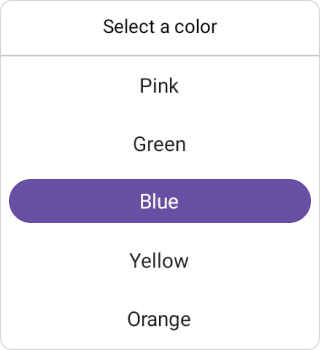
Add picker items to the picker
The .NET MAUI Picker control is a data-bound control. Hence, you must create a data collection and bind it to the picker control.
- Create a simple Observable Collection of data for the picker,
public class ItemInfo
{
private ObservableCollection<object> dataSource = new ObservableCollection<object>()
{
"Pink", "Green", "Blue", "Yellow", "Orange", "Purple", "SkyBlue", "PaleGreen"
};
public ObservableCollection<object> DataSource
{
get
{
return dataSource;
}
set
{
dataSource = value;
}
}
public ItemInfo()
{
}
}- Bind the Collection to picker
The Picker control allows you to bind data collection by setting the ItemsSource property from the PickerColumn. Bind data collection in both XAML and C#.
<picker:SfPicker x:Name="picker">
<picker:SfPicker.HeaderView>
<picker:PickerHeaderView Text="Select a color" Height="40" />
</picker:SfPicker.HeaderView>
<picker:SfPicker.Columns>
<picker:PickerColumn ItemsSource="{Binding DataSource}" />
</picker:SfPicker.Columns>
</picker:SfPicker>
<ContentPage.BindingContext>
<local:ItemInfo />
</ContentPage.BindingContext>
ItemInfo itemInfo = new ItemInfo();
SfPicker picker = new SfPicker()
{
Columns = new ObservableCollection<PickerColumn>()
{
new PickerColumn()
{
ItemsSource = itemInfo.DataSource,
}
}
};
this.Content = picker;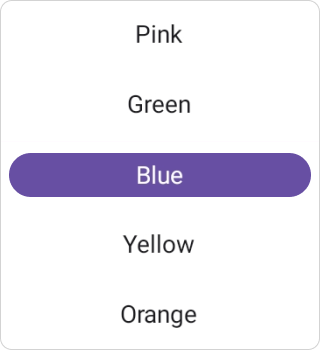
Set footer to the Picker
In SfPicker control, validation buttons (OK and Cancel) can be customized by setting the OkButtonText and CancelButtonText properties in the PickerFooterView. It allows you to confirm or cancel the selected item. The OkButtonText can be enabled using the ShowOkButton property in the PickerFooterView.
<picker:SfPicker x:Name="picker">
<picker:SfPicker.FooterView>
<picker:PickerFooterView ShowOkButton="True" Height="40" />
</picker:SfPicker.FooterView>
</picker:SfPicker>SfPicker picker = new SfPicker();
picker.FooterView= new PickerFooterView()
{
ShowOkButton = true,
Height = 40,
};
this.Content = picker;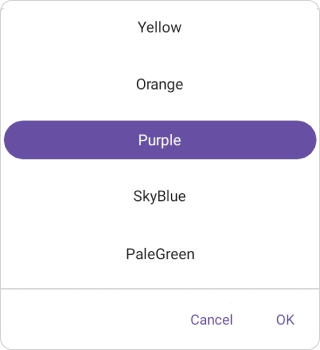
Set column header to the Picker items
The SfPicker control allows you to add the column header text by setting the HeaderText property in the PickerColumn, and you need to add the column header height by setting the Height property in the PickerColumnHeaderView. Its text style and background color are customizable.
<picker:SfPicker x:Name="picker">
<picker:SfPicker.HeaderView>
<picker:PickerHeaderView Text="Select a color" Height="40" />
</picker:SfPicker.HeaderView>
<picker:SfPicker.Columns>
<picker:PickerColumn HeaderText="Colors"
ItemsSource="{Binding DataSource}" />
</picker:SfPicker.Columns>
<picker:SfPicker.ColumnHeaderView>
<picker:PickerColumnHeaderView Height="40" />
</picker:SfPicker.ColumnHeaderView>
</picker:SfPicker>ItemInfo itemInfo = new ItemInfo();
SfPicker picker = new SfPicker()
{
HeaderView = new PickerHeaderView()
{
Text = "Select a color",
Height = 40,
},
Columns = new ObservableCollection<PickerColumn>()
{
new PickerColumn()
{
HeaderText = "Colors",
ItemsSource = itemInfo.DataSource,
}
},
ColumnHeaderView = new PickerColumnHeaderView()
{
Height = 40,
},
};
this.Content = picker;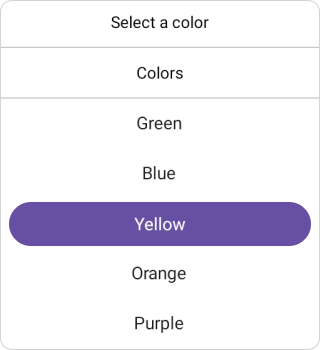
Set height and width to the Picker
The SfPicker control allows you to change the height and width by using the [HeightRequest] and [WidthRequest] properties in the SfPicker.
<picker:SfPicker x:Name="picker"
HeightRequest="280"
WidthRequest="300">
</picker:SfPicker>SfPicker picker = new SfPicker()
{
HeightRequest = 280,
WidthRequest = 300,
};
this.Content = picker;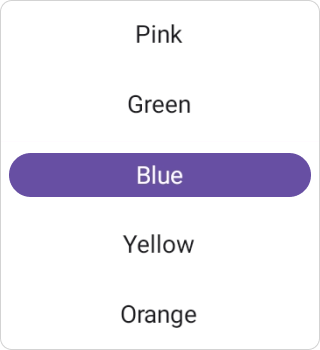
NOTE
You can refer to our .NET MAUI Picker feature tour page for its groundbreaking feature representations. You can also explore our .NET MAUI Picker Example that shows you how to render and configure the Picker in .NET MAUI.